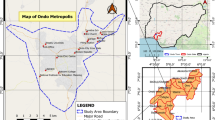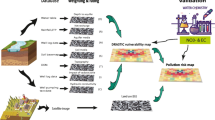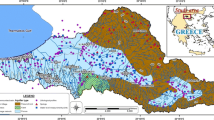Abstract
Karst terrains appear on all continents and karst aquifers produce drinking water for more than 9% of the world’s population while being the most vulnerable to contamination. One of the main challenges in the management of a water supply that depends on groundwater is the possibility of the pollution of the karst aquifer which is usually open toward the surface and is highly permeable. Various environmental problems found in karstic areas demand a completely unconventional approach for this particular environment. To achieve and maintain high-quality groundwater that can be used for a public water supply, an effective prevention program must be designed and implemented. The process of determining the sanitary protection zones (SPZ) has been relying on new technologies, especially the use of a geographic information system (GIS) environment. An assortment of groundwater vulnerability assessment methods has been developed in the GIS environment, as a necessary basis for implementing preventive measures. Suva Planina Mountain is one of the greatest and the highest karst massifs in South-East Serbia. Almost all known karst features are present, and several karst springs exist at the foothill of the mountain. The largest springs have been captured for the water supply. The catchment areas of the springs are not populated and there is no industry, besides grazing and forestry; nevertheless, some limits for human impact must be enacted. This paper is an attempt at using the GIS-overlay spatial modeling technique for groundwater vulnerability assessment of Suva Planina Mountain. Maps of intrinsic vulnerability have been designed by the application of three multi-parameter methods for vulnerability mapping (EPIK, PI, COP). The maps that have been designed for Suva Planina Mountain show the existence of four classes of vulnerability, though in somewhat different arrangements and distribution.








Similar content being viewed by others
References
Albinet M, Margat J (1970) Cartographie de la vulnerabilité à la pollution des nappes d’eau souterraines. Bull BRGM 2ème série 3(4):13–22
Bakalowicz M (2005) Karst groundwater: a challenge for new resources. Hydrogeol J 13(1):148–160. https://doi.org/10.1007/s10040-004-0402-9
Chen Z, Auler AS, Bakalowicz M, Drew D, Griger F, Hartmann J, Jiang G, Moosdorf N, Richts A, Stevanovic Z, Veni G, Goldscheider N (2017) The World Karst Aquifer Mapping project: concept, mapping procedure and map of Europe. Hydrogeol J 25(3):771–785. https://doi.org/10.1007/s10040-016-1519-3
Cvijić J (1912) Suva Planina Mountain and karst surface Valožje” (In Serbian). The Messenger of Serbian Geographical Society, book 1, Belgrade
Daly D, Dassargues A, Drew D, Dunne S, Goldscheider N, Neale S, Popescu IC, Zwahlen F (2002) Main concepts of the European approach for (karst) groundwater vulnerability assessment and mapping. Hydrogeol J 10(2):340–345
Doerfliger N, Jeannin PY, Zwahlen F (1999) Water vulnerability assessment in karst environments: a new method of defining protection areas using a multi-attribute approach and GIS tools (EPIK method). Environ Geol 39(2):165–176. https://doi.org/10.1007/s002540050446
Federal Geological Survey of SFRY (Dimitrijević M, Dragić D, Karamata S, Sikošek B, Petrović B, Veselinović D) (1980) Map and explanatory text of the Basic geological map of SFRY, sheet Bela Palanka—K 34–33, R=1:100000, p 69
Ford D, Williams P (2007) Karst hydrogeology and geomorphology. Wiley, Chichester, p 562
Foster S, Hirata R, Andreo B (2013) The aquifer pollution vulnerability concept: aid or impediment in promoting groundwater protection? Hydrogeol J 21:1389–1392. https://doi.org/10.1007/s10040-013-1019-7
Gogu RC, Hallet V, Dassargues A (2003) Comparison of aquifer vulnerability assessment techniques. Application to the Néblon river basin (Belgium). Environ Geol 44(8):881–892. https://doi.org/10.1007/s00254-003-0842-x.
Goldscheider N, Klute M, Sturm S, Hötzl H (2000) The PI method – a GIS-based approach to mapping groundwater vulnerability with special consideration of karst aquifers. Z Angew Geol 46:157–166
Goldscheider N (2005) Karst groundwater vulnerability mapping: application of a new method in the Swabian Alb, Germany. Hydrogeol J 13(4):555–564. https://doi.org/10.1007/s10040-003-0291-3
Iván V, Mádl-Szőnyi J (2017) State of the art of karst vulnerability assessment: overview, evaluation and outlook. Environ Earth Sci 76:112. https://doi.org/10.1007/s12665-017-6422-2
Kazakis N, Voudouris K (2011) Comparison of three applied methods of groundwater vulnerability mapping: a case study from the Florina basin, Northern Greece. In: Proceedings of 9th international hydrogeological congress, Kalavrita, Greece. Advances in the Research of Aquatic Environment, vol 2. Springer, pp 359–367
Kazakis N, Oikonomidis D, Voudouris KS (2015) Groundwater vulnerability and pollution risk assessment with disparate models in karstic, porous, and fissured rock aquifers using remote sensing techniques and GIS in Anthemountas basin, Greece. Environ Earth Sci 74(7):6199–6209. https://doi.org/10.1007/s12665-015-4641-y
Kazakis N, Chalikakis K, Mazzilli N, Ollivier C, Manakos A, Voudouris K (2018) Management and research strategies of karst aquifers in Greece: Literature overview and exemplification based on hydrodynamic modelling and vulnerability assessment of a strategic karst aquifer. Sci Total Environ 643:592–609. https://doi.org/10.1016/j.scitotenv.2018.06.184
Law on Water (2010) Official Gazette of RS, No. 30/2010, and amendments: Official Gazette of RS 93/2012, 101/16 and 95/2018
Machiwal D, Cloutier V, Güler C, Kazakis N (2018) A review of GIS-integrated statistical techniques for groundwater quality evaluation and protection. Environ Earth Sci 77:681. https://doi.org/10.1007/s12665-018-7872-x
Margat J (1968) Vulnerabilité des nappes d’eau souterraine à la pollution [Contamination vulnerability mapping of groundwater]. Bureau de Recherches Géologiques et Minières, Orleans
Neukum C, Hötzl H (2005) Standardization of vulnerability maps. In: Stevanović Z, Milanović P (eds) Proceedings of international conference “Water Resources and Environmental Problems in Karst—CVIJIĆ 2005”, Beograd-Kotor, p 11–19
Petrović B (2014) Preliminary characterization of the karst groundwater flow of Suva Planina Mountain (Eastern Serbia). In: Kukurić N, Stevanović Z, Krešić N (eds) Proceedings of the DIKTAS Conference: “Karst without boundaries”, Trebinje and Dubrovnik, ISBN: 978-99938-52–58-2, pp 230–236
Petrović B, Marinović V, Stevanović Z, Milanović S, Vasić Lj, (2017) EPIK Intrinsic groundwater vulnerability assessment and statistical sensitivity analysis: case studies from Serbian Karst. In: Abstracts 44th annual congress of the international association of hydrogeologist (IAH) “Groundwater Heritage and Sustainability” Dubrovnik, Croatia, ISBN: 978-953-6907-61-8
Stevanović Z (1991) The hydrogeology of karst aquifers of Carpatho-Balkanides of Eastern Serbia and possibilities of water supply (in Serbian, Abstract in English), Special edition of Faculty of Mining and Geology, University of Belgrade, p 245
Stevanović Z (2010) Case study: Major springs of southeastern Europe and their utilization. In: Kresic N, Stevanovic Z (eds) Groundwater hydrology of springs, 1st edn. Butterworth-Heinemann (Elsevier), ISBN: 9781856175029, pp 389–410
Stevanović Z (2017) Karst aquifer as one of the major global water sources—state of art and perspectives. In: 44th annual congress of the international association of hydrogeologists (IAH) “Groundwater Heritage and Sustainability”, Dubrovnik, Croatia, ISBN: 978-953-6907-61-8, pp 278
Stevanović Z, Filipović B (1994) Hydrogeology of carbonate rocks of Carpatho-Balkanides, In: Stevanović Z, Filipović B (eds) Ground waters in carbonate rocks of the Carpathian-Balkan mountain range, Spec. ed. of CBGA, Allston, Jersey
The rulebook on the manner of determining and maintaining the sanitary protection zones of water supply sources (2008) Official Gazette of RS, No. 92
Vías JM, Andreo B, Perles MJ, Carrasco F (2005) A comparative study of four schemes for groundwater vulnerability mapping in a diffuse flow carbonate aquifer under Mediterranean climatic conditions. Environ Geol 47(4):586–595. https://doi.org/10.1007/s00254-004-1185-y
Vías JM, Andreo B, Perles MJ, Carrasco F, Vadillo I, Jiménez P (2006) Proposed method for groundwater vulnerability mapping in carbonate (karstic) aquifers: the COP method. Hydrogeol J 14(6):912–925. https://doi.org/10.1007/s10040-006-0023-6
Witkowski AJ, Kowalczyk A, Vrba J (2007) Groundwater vulnerability assessment and mapping: IAH-selected papers. Taylor & Francis, Milton Park
Zwahlen F (2004) Vulnerability and risk mapping for the protection of carbonate (karst) aquifers, final report (COST action 620). European Commission, Directorate-General XII Science, p 297
Živanović V (2011) Pollution vulnerability assessment of groundwater—examples of Karst in Serbia (in Serbian, Abstract in English). MSc Thesis, Faculty of Mining and Geology, University of Belgrade, p. 215
Acknowledgements
This research was supported by the Fund of the Ministry of Education, Science and Technological Development of the Republic of Serbia—Project No. 176022.
Author information
Authors and Affiliations
Corresponding author
Additional information
Publisher's Note
Springer Nature remains neutral with regard to jurisdictional claims in published maps and institutional affiliations.
This article is a part of a Topical Collection in Environmental Earth Sciences on Sustainable Management of Karst Natural Resources, guest edited by Drs. Sasa Malinovic and Zoran Stevanovic.
Rights and permissions
About this article
Cite this article
Petrović, B. Intrinsic groundwater vulnerability assessment by multiparameter methods, a case study of Suva Planina Mountain (SE Serbia). Environ Earth Sci 79, 85 (2020). https://doi.org/10.1007/s12665-020-8825-8
Received:
Accepted:
Published:
DOI: https://doi.org/10.1007/s12665-020-8825-8




